 I know what you’re thinking…a scarf in the summer?
I know what you’re thinking…a scarf in the summer?
Definitely not in Texas.
BUT, if you’re like me…..when the summer heat comes and the A/C is pumping…..if I’m inside a store, church, or movie theater for longer than an hour, I actually start to get cold.
Solution? Summer scarf. Made of soft cotton seersucker or linen fabric, it’s girly and breezy.
 This scarf is so light-weight you hardly notice it’s there (but they’ll notice your darling ruffles).
This scarf is so light-weight you hardly notice it’s there (but they’ll notice your darling ruffles).
It’s the perfect accessory for a spring outing to the Poppy Festival. Or a pleasant summer evening walk along the beach.
And guess what? It’s truly one of the easiest things I’ve made. I know I tell you that a lot, but I’m not joking! Simple, simple. The largest margin of “time spent-to-cuteness” returns on my blog. That’s saying something, right?
 We’ll even show you two methods for making the scarf (in case Elastic Thread doesn’t work in your sewing machine)
We’ll even show you two methods for making the scarf (in case Elastic Thread doesn’t work in your sewing machine)
 Let’s get started!
Let’s get started!
Fabric Choice:
Use a very light-weight cotton, sear sucker, knit or linen; fabrics that seem to “breathe” and will give your scarf a bounce. (If you use knit, you don’t need to do anything to the edges. Just leave them raw. Your project time just got cut in half!)
You need about a 1/2 yard of fabric for the measurements listed below.
My fabric was purchased on clearance at M&L Fabrics in Anaheim, Calif. It’s a very light-weight seersucker.
Cut strips of fabric so that you end up with one long strip that’s about 125 x 6 inches (318 x 15 cm). I cut out three long strips and sewed them together on the ends.

 Serge all the way around the outside of your entire scarf, ends and sides. If you don’t have a serger or if you want a more polished look, you don’t need to serge. Instead, iron all the sides over about 1/4 or 1/2 an inch and then skip to the next step.
Serge all the way around the outside of your entire scarf, ends and sides. If you don’t have a serger or if you want a more polished look, you don’t need to serge. Instead, iron all the sides over about 1/4 or 1/2 an inch and then skip to the next step.
 Iron over all the edges of your scarf about a 1/2 inch:
Iron over all the edges of your scarf about a 1/2 inch:

 It should look something like this:
It should look something like this:
 Sew this “hem” down, all the way around the scarf:
Sew this “hem” down, all the way around the scarf:
 Here’s your scarf, ready to be ruffled:
Here’s your scarf, ready to be ruffled:
 To get the ruffle, we’re using Elastic Thread. Simple!
To get the ruffle, we’re using Elastic Thread. Simple!
NOTE: IF THE ELASTIC THREAD is NOT gathering up on your scarf, a few things you can try:
* Spray your scarf with water and ironing. This usually does the trick.
* You may need to adjust your bobbin tension (esp if you have a BROTHER machine). See this tutorial HERE.
* You can make a scarf without using Elastic Thread. See our Summer Scarf, Version 2 below.
You can Elastic Thread at most sewing stores in the notions area, or online (about $2). For very detailed info on sewing with Elastic Thread, please see our Summer Vacation Dress and Shortie Pattern. But this tutorial should tell you all you need to know for your scarf.
Okay, so wind the elastic thread around your bobbin. Not too tight, not too loose, just somewhere in the middle. And load it into your machine:

 With normal thread on the top of your machine, you’re ready to gather. Start in the middle of your scarf (make sure you are sewing on the TOP of your scarf, the nicer looking part). Do a stay stitch (back and forth stitch at the beginning). And just start sewing down in a straight-ish line. Don’t worry about drawing a line on your scarf. Just eyeball it. It’s going to be all gathered up and ruffled when you’re done, so if you’re a little off, no one will know.
With normal thread on the top of your machine, you’re ready to gather. Start in the middle of your scarf (make sure you are sewing on the TOP of your scarf, the nicer looking part). Do a stay stitch (back and forth stitch at the beginning). And just start sewing down in a straight-ish line. Don’t worry about drawing a line on your scarf. Just eyeball it. It’s going to be all gathered up and ruffled when you’re done, so if you’re a little off, no one will know.
 Watch the fabric gather up behind you. I love it every time!
Watch the fabric gather up behind you. I love it every time!
 Continue to the end and do another stay stitch.
Continue to the end and do another stay stitch.
 Then, repeat this one more time, doing another line of elastic thread about 1/4 inch or 1/2 inch from the first line. Don’t worry if it’s not completely centered on your scarf.
Then, repeat this one more time, doing another line of elastic thread about 1/4 inch or 1/2 inch from the first line. Don’t worry if it’s not completely centered on your scarf.
 And voila, you’re done!
And voila, you’re done!
You can add more or less lines if you’d like. Here are my observations after making 2 scarves :
* Why not just sew ONE line of Elastic Thread? I found that doing one line felt too weak, like it was going to snap. Two gave it more strength.
* I also tried it with multiple lines which spread further out on the scarf but it’s a totally different look. It won’t ruffle and twist as it does in the photos here. It will lay more flat and look like a shirred scarf.
Okay, tie it around your neck! (no special method here, just one simple tie, like you’re getting ready to tie shoelaces).
 It should look like this on the front:
It should look like this on the front:
 and this on the back:
and this on the back:
 with lots and lots of summer ruffles in between!
with lots and lots of summer ruffles in between!

IF ELASTIC THREAD IS NOT WORKING IN YOUR MACHINE…..
 In these steps, we’ll be gathering our scarf the old-fashioned way. By doing that, the only way for the gathers to stay in place is by adding a strip of fabric on the top, to secure the gathers, so that nothing moves. It gives the summer scarf a slightly different look, takes twice the time, and doesn’t seem quite as ruffly to me (but that also may be because my fabric wasn’t quite as light-weight and “bouncy” as the scarf above). BUT it’s still a darling and a great alternative if you can’t use Elastic Thread!
In these steps, we’ll be gathering our scarf the old-fashioned way. By doing that, the only way for the gathers to stay in place is by adding a strip of fabric on the top, to secure the gathers, so that nothing moves. It gives the summer scarf a slightly different look, takes twice the time, and doesn’t seem quite as ruffly to me (but that also may be because my fabric wasn’t quite as light-weight and “bouncy” as the scarf above). BUT it’s still a darling and a great alternative if you can’t use Elastic Thread!
So here’s how it’s done…..
Prep your scarf just as you did in the steps above.
 Cut a strip of fabric about 50 x 1 1/2 inches (127 x 4 cm). This is the strip that will hold your gathers in place. If you want it to blend-in, use the same fabric. If you want it to stand out, use a contrasting fabric. You could also use ribbon, bias tape, I’m sure you can think of more!
Cut a strip of fabric about 50 x 1 1/2 inches (127 x 4 cm). This is the strip that will hold your gathers in place. If you want it to blend-in, use the same fabric. If you want it to stand out, use a contrasting fabric. You could also use ribbon, bias tape, I’m sure you can think of more!
 Iron the sides of your strip over on all sides, so that you have one long strip of fabric, about 1/2 inch (1 cm) wide. It will look sort of like store-bought Bias Tape when you’re done.
Iron the sides of your strip over on all sides, so that you have one long strip of fabric, about 1/2 inch (1 cm) wide. It will look sort of like store-bought Bias Tape when you’re done.
 Now, start gathering. Do NOT do a stay stitch (a back and forth stitch at the beginning) and set your machine to the longest stitch. Sew a straight line all the way down the middle of the scarf. Just eyeball it. Doesn’t need to be perfect.
Now, start gathering. Do NOT do a stay stitch (a back and forth stitch at the beginning) and set your machine to the longest stitch. Sew a straight line all the way down the middle of the scarf. Just eyeball it. Doesn’t need to be perfect.
 When you get to the end, do NOT do a stay stitch and leave the threads long at the end.
When you get to the end, do NOT do a stay stitch and leave the threads long at the end.
Sew another line about 1/4 or 1/2 inch next to the one before (remember not to Stay Stitch). Do NOT cross your lines (or as Egon says, Don’t cross the streams! ) If this happens, the gathering will not work.
 Gathering is much easier to do if you’ve sewn two lines to pull from (rather than only sewing one). Three lines are even better. But two is fine for this project.
Gathering is much easier to do if you’ve sewn two lines to pull from (rather than only sewing one). Three lines are even better. But two is fine for this project.
Okay, taking both the threads from the front (or both the threads from the back, but make sure you’re grabbing both threads from the same side), start pulling them and pushing the fabric down so that it gathers up.
 Continue this process….shifting, pulling thread, pushing fabric down, etc.
Continue this process….shifting, pulling thread, pushing fabric down, etc.
 Do this until the scarf is gathered to your desired length or the length of the strip you just ironed.
Do this until the scarf is gathered to your desired length or the length of the strip you just ironed.
 Take that strip and pin it right on top of the gathered threads, so that it hides the thread underneath and holds the gathers in place.
Take that strip and pin it right on top of the gathered threads, so that it hides the thread underneath and holds the gathers in place.
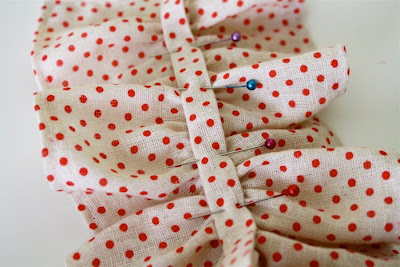 Pin it all the way down to the other end:
Pin it all the way down to the other end:
 When you get to the ends, tuck the end of the fabric strip under:
When you get to the ends, tuck the end of the fabric strip under:
 And pin it in place on the other side:
And pin it in place on the other side:
 Then, sew it in place! Sew down one side:
Then, sew it in place! Sew down one side:
 Use your fingers to push spread the fabric as you go, so that the gathers are spread evenly:
Use your fingers to push spread the fabric as you go, so that the gathers are spread evenly:
 then sew down the other side:
then sew down the other side:
 And you’re done!
And you’re done!
 One ruffly Summer Scarf without Elastic thread, coming right up!
One ruffly Summer Scarf without Elastic thread, coming right up!
 Tie it on!
Tie it on!

 And enjoy your afternoon.
And enjoy your afternoon.




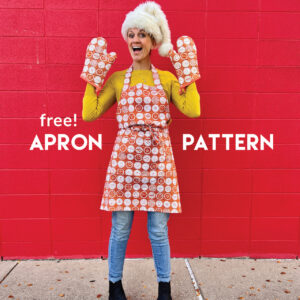
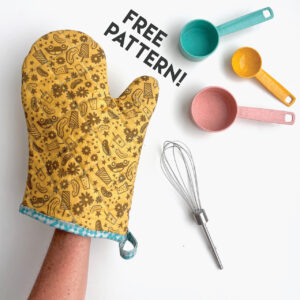
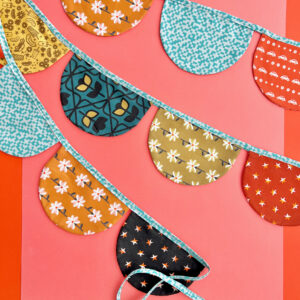
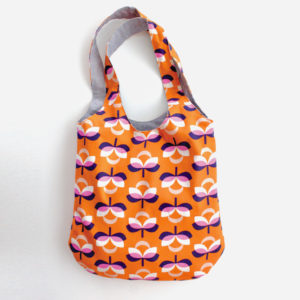




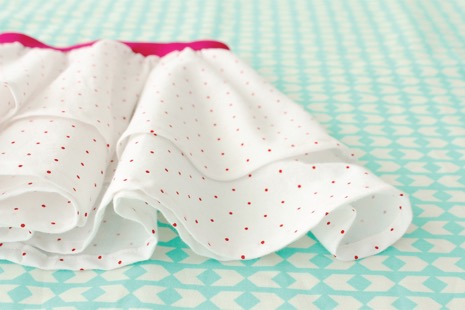










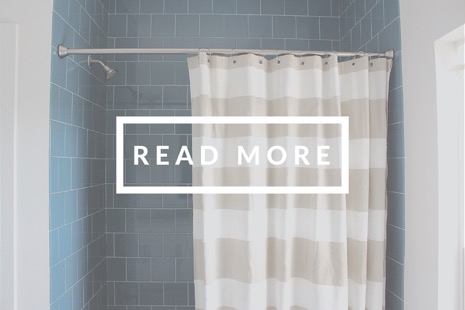
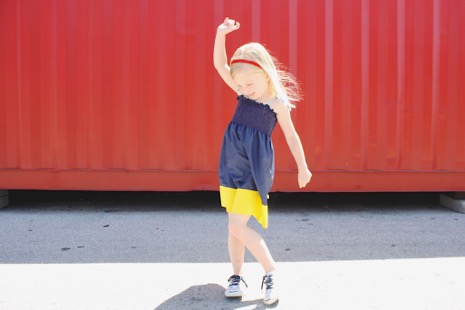


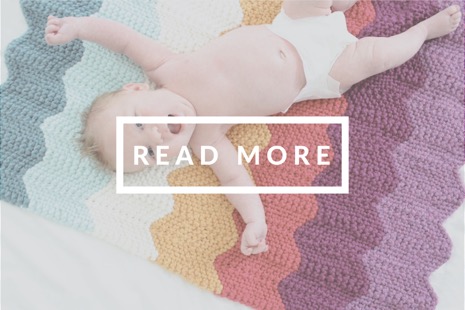

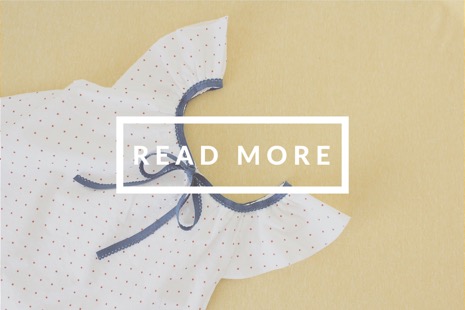


I love this! I tried this with a thin knit and it came across too floppy once it was done; more of the backside shows than the front because it doesn’t have enough body to hold the ruffles. I will definitely be trying this with a sturdier knit or woven. Thank you for all the great tutorials and project ideas!!!
Looooove this. Your directions were so clear and simple. I can’t wait to try this.!
Great tutorial… I never even thought of using elastic thread! Genius.
I’m wondering why you couldn’t just use a ruffler foot and then do a straight stitch directly on top of the ruffled stitch line to hold it better? Would be no elastic thread to show and no bias tape (or thread pulling!) either.
May have already been mentioned and lost when the site moved over, sorry if it has.
I tried this with ruffling then sewing zig zag on top once I got the ruffles the way I wanted them. Worked perfectly!
Hi! I am debating between making my scarf with elastic to gather or using the ruffler foot. I am using a pretty pink voile and the only thing about the elastic is that it is white. But i’m thinking if I use the ruffler foot, I won’t get the fun stretch in the scarf. What do you prefer or recommend?
What a fun, quick project! Would a knit work, for the fall/winter?
Hello. I’m french and live near Paris. I’m interested by this scarf and the tuto because every tuesday, I go to the hospital with adolescents sick to distract them and make craft and sewing. (excuse my bad english..)
Could you tell me what is the length of the finished scarf? Thank you for your reply
I think you could make this any length – You’d just change the original length of fabric you prepared. Measuring One of your own scarves that you like the length of might be a good start – remember to allow for the ruffling though!
Hello!! I’m from Brazil, and I really liked your tutorial on how to sew a ruffle scarf! I want to make one of these for my mother’s birthday. But I think I bought the wrong fabric. I bought one that is really really thin, delicate. It is beautiful, but I’m a beginner in sewing, I’ve only made a few easy projects, so I’m worried about the thread tension and needle size and all that. What do you recommend? Do you think is possible to make this scarf with a really thin fabric?
Thank You!
Obrigada!
I purchased some elastic thread after watching a sewing show on television about 6 months ago. I purchased it to eventually make some smock tops but made my step grandchild a shirring top. I made 2 to sell at my garage sell at the church. Now I have lots of material and started selling scarves. I was actually searching for Sewing with Nancy because she show how to use the elastic thread to make scarves and I found you. My machine is old but it works with the elastic thread very well. Keep up the good work. I wanted to make different type of scarves instead of the straight ones. Your blog is amazing. I have a serger and will just have to take time learning how to use it.
Hello..I’m from Nigeria and I just started learning how to sew.Your blog has made sewing very interesting…I love this blog more than words can say you’re doing a great job..Bravo!